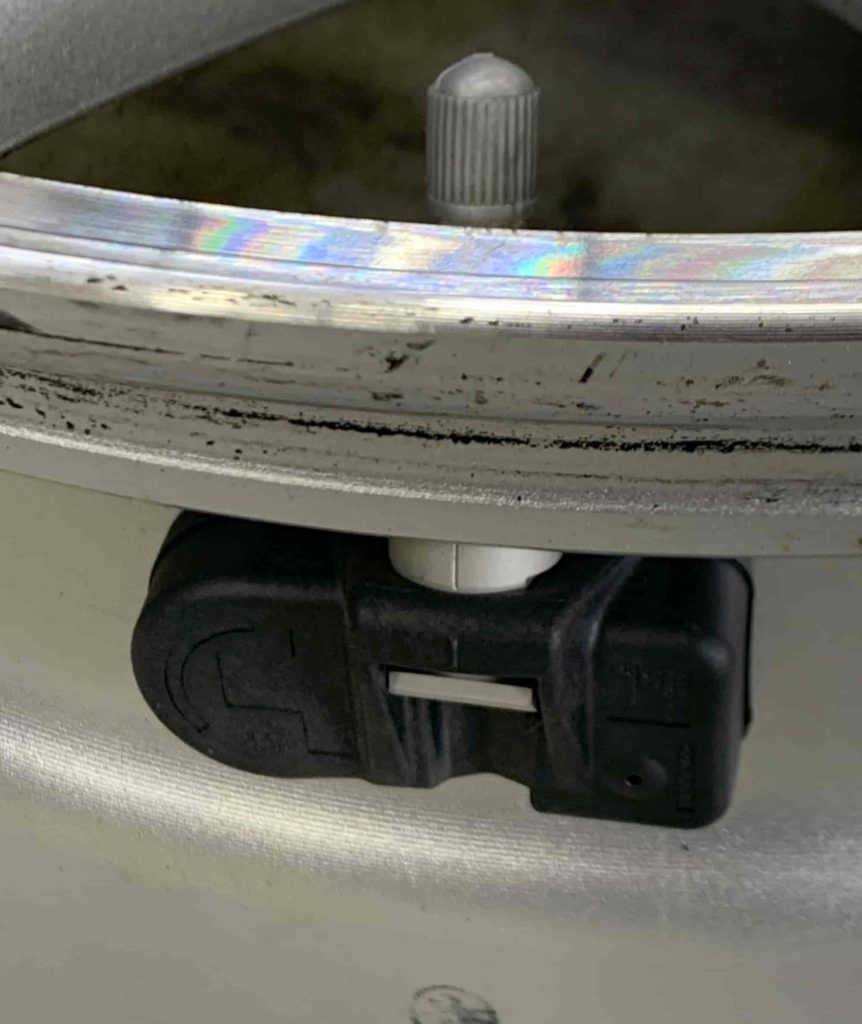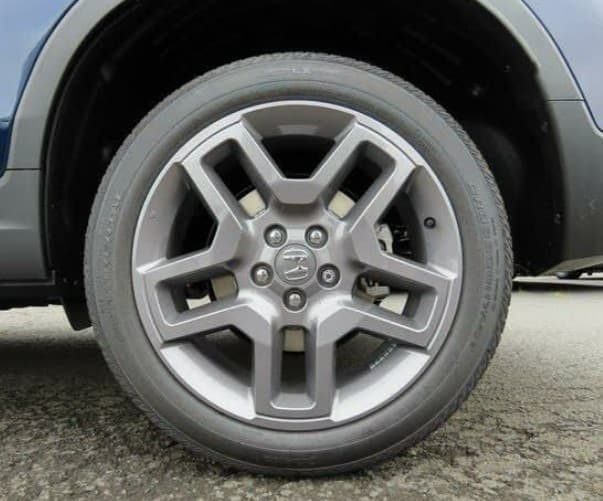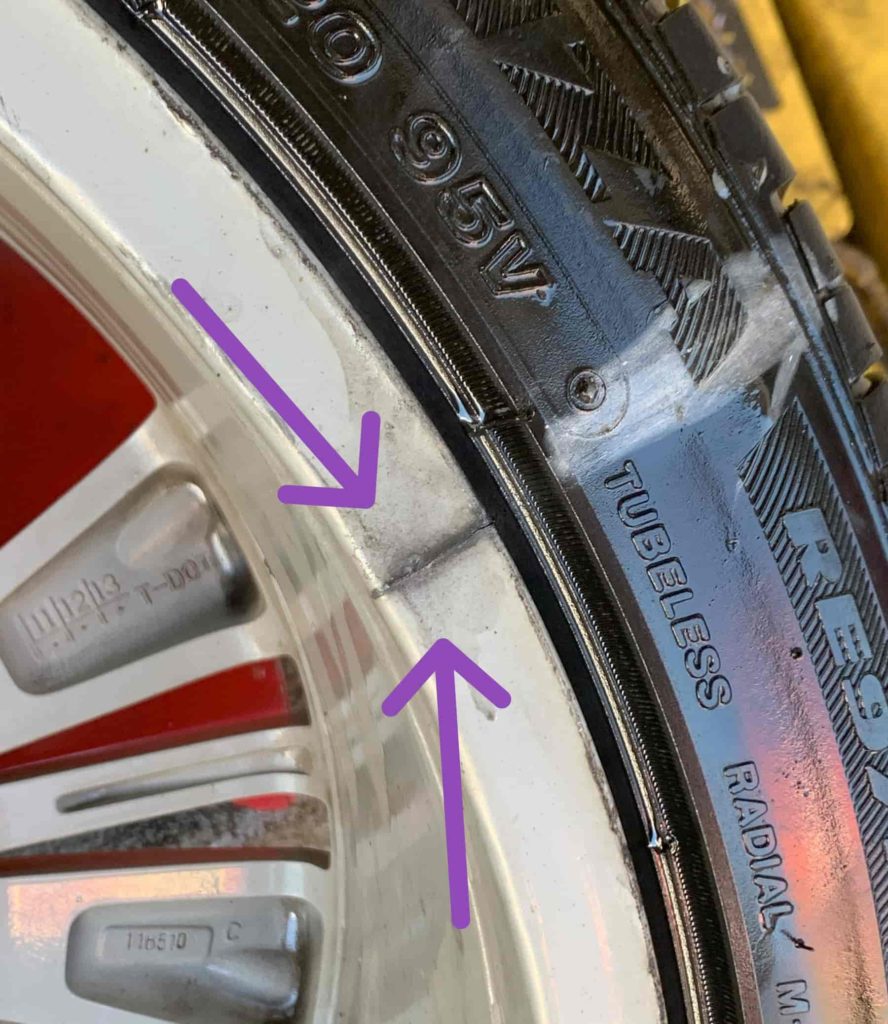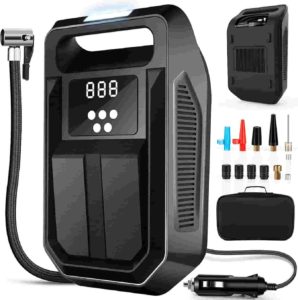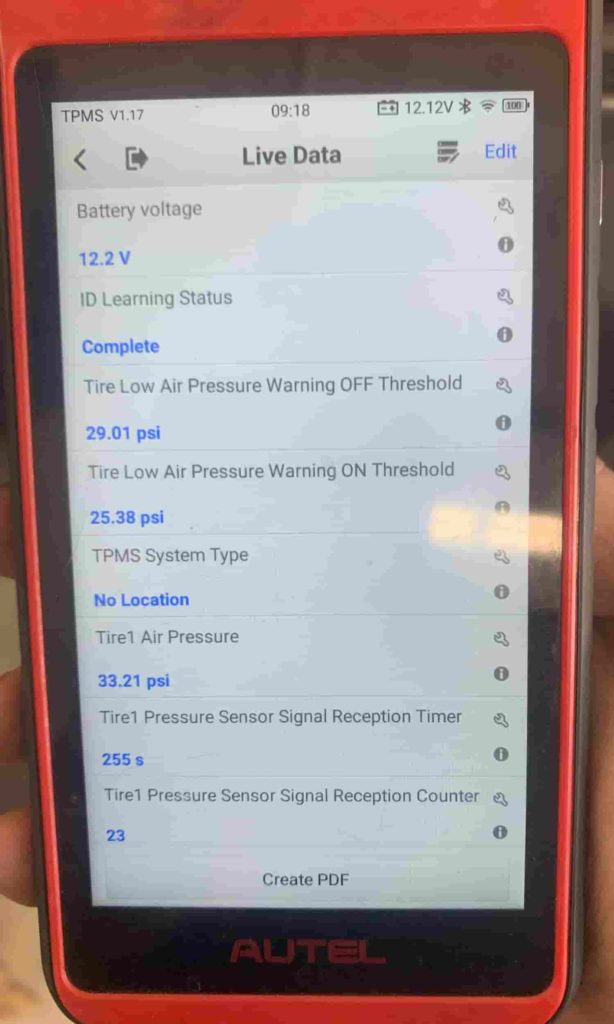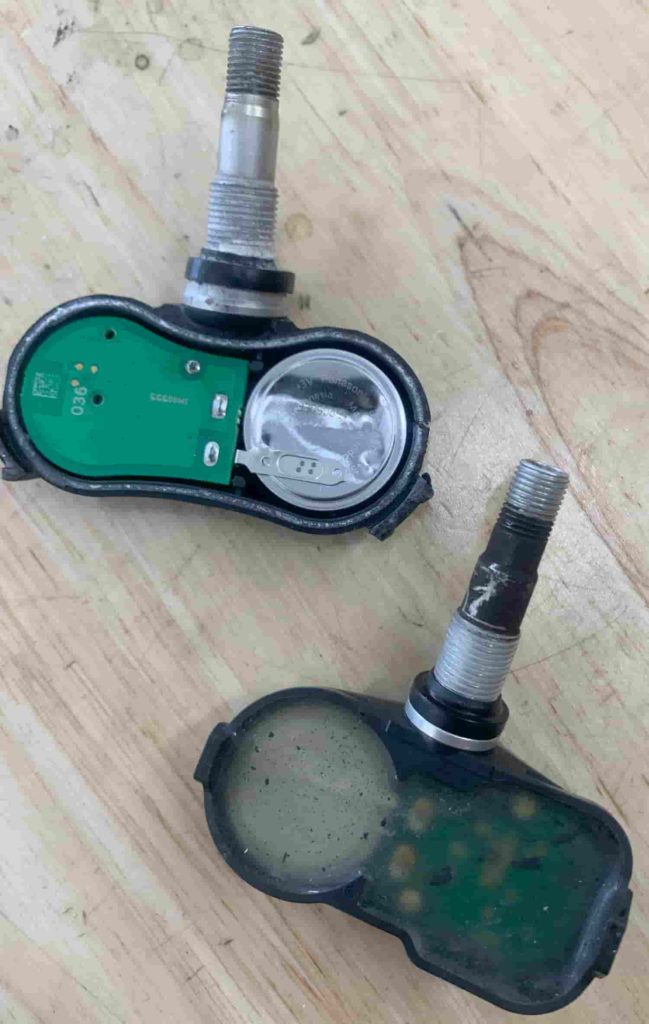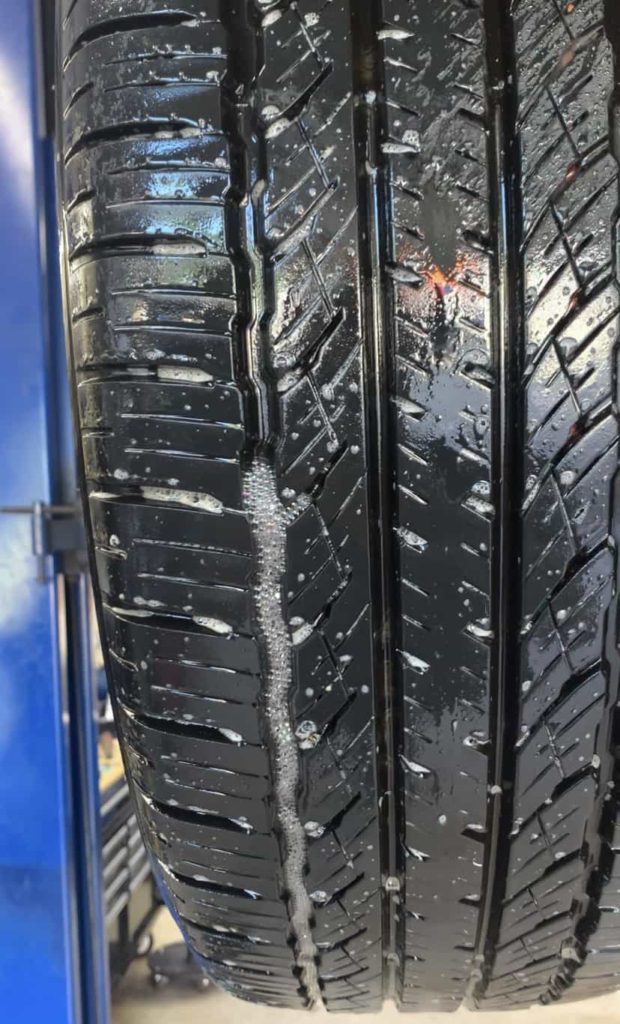How Does the Honda Passport TPMS Work?
Sensors: Each of the Honda Passport’s tires is equipped with a tire pressure sensor, located inside the tire attached to the valve stem. These sensors are able to measure the air pressure within the tire and transmit this data to the vehicle’s computer system.
Data Transmission: The sensors transmit data via radio frequency signals to the receiver/control module in the car as the car is moving. In the Honda Passport, these signals are typically sent every few minutes while driving, but the frequency can increase if the sensors detect a sudden drop in tire pressure.
Monitoring: The receiver/control module is constantly monitoring these signals. It interprets the data and if it notices that the pressure in one or more of the tires is below the manufacturer’s recommended level (which for most Honda Passports is around 35 Psi but can vary by model and tire size), it triggers an alert.
Alerting the Driver: If low tire pressure is detected, the TPMS will trigger a warning light on the dashboard, represented as an orange or yellow exclamation point inside an outline of a tire. The driver information interface might also display a “CHECK TIRE PRESSURE” or “LOW TIRE PRESSURE” message. The “tire pressure” option in the infotainment system will also specify which tire is under-inflated.
Action Required: Once alerted, the driver should take action as soon as possible. Driving with low tire pressure can increase tire wear, negatively impact fuel economy, and pose a safety risk. After the pressure has been corrected, the TPMS warning light will usually go off after a few minutes of driving but should still be calibrated.
How to Reset Honda Passport Tire Pressure Light
Steps to Reset Honda Passport TPMS (2018-2023)
Step 1: Check and Adjust the Tire Pressure and make sure all 4 tires are at the correct pressure levels.
Step 2: Turn the ignition to the ON position (press engine start button twice without your foot on the brake) or have the vehicle running.
Step 3: Select the HOME button on the top left of the infotainment system.
Step 4: Select SETTINGS on the infotainment screen.
Step 5: Select VEHICLE on the infotainment screen.
Step 6: Select TPMS CALIBRATION.
Step 7: Select CALIBRATE.
Step 8: Drive the Honda Passport for a few miles at speeds over 20 Mph to finalize the calibration process.
How to Check Current Tire Pressure in Honda Passport
To access and check the current tire pressure on your Honda Passport, use the buttons on your steering wheel:
Switch the ignition to ON.
Select the “Home” button on the steering wheel.
Select the up or down arrows on the left side of the steering wheel until you see the “Maintenance” option.
Select the “ENTER” button and navigate to “Tire Pressure”
Select the “ENTER” button. The current tire pressure details will now be displayed on the driver information interface.
Recalibrate the Honda Passport TPMS When:
After tire pressure has adjusted (inflated or deflated to correct the pressure).
After a TPMS sensor has been replaced or swapped.
After a tire rotation.
After tire balances or wheel alignments.
After any tire or wheel has been replaced. This includes swapping winter and summer tires.
After your Honda Passport battery dies, is jumped, or charged.
Understanding Tire Pressure
Does the Weather Affect Tire Pressure?
The tire pressure in your Honda Passport is significantly influenced by weather conditions, primarily due to changes in temperature. Air molecules expand when heated and contract when cooled. This is a principle that applies to the air inside your vehicle’s tires. During warm or hot weather the air inside the tires will expand which will potentially increase the tire pressure. (This also occurs after driving long distances) Conversely in cold weather the air contracts, and tire pressure will decrease. A rule of thumb is that for every 10-degree Fahrenheit change in temperature, tire pressure will change about 1 psi. For instance, if the temperature drops significantly overnight it’s not uncommon for the Tire Pressure Monitoring System (TPMS) in your Passport to activate, indicating a low-pressure warning.
How to Check Honda Passport Tire Pressure
Prepare Your Tools: You will need a tire pressure gauge. There are different types, including digital and manual (dial or stick) gauges and either one is fine.
Wait for Tires to Cool Down: Tires should be “cold” when you check the pressure. That means they haven’t been driven on for at least three hours.
Find the Recommended Pressure: Check your owner’s manual or the placard sticker on the driver’s side door jamb to find the recommended tire pressure for your Honda Passport.
Remove the Valve Cap: The valve cap is the small cap on your tire’s valve stem. Twist the cap counterclockwise to remove it.
Check the Pressure: Place the tire pressure gauge onto the valve stem and press down hard enough so that the hiss sound disappears and your gauge provides a reading. With a digital gauge the tire pressure will show on the screen. With a manual gauge a small bar will pop out from the bottom of the gauge showing the pressure.
Compare to Recommended Pressure: Compare the tire pressure reading to the recommended tire pressure. If the reading is lower than the recommended level you’ll need to inflate your tires. If it’s higher, you’ll need to let some air out.
Replace the Valve Cap: Screw the valve cap back onto the valve stem by twisting it clockwise. Make sure it’s secure.
Repeat for All Tires: Repeat this process for all four tires. The Honda Passport spare tire should also be checked and requires 60 Psi.
2023 Honda Passport Wheel Size & Tire Pressure
TIRE SIZE | FRONT PSI | REAR PSI |
245/60R18 | 35 | 35 |
265/45R20 | 37 | 37 |
SPARE | 60 | 60 |
Impact of Driving With Underinflated Tires
Driving a Honda Passport with underinflated tires can have several negative impacts:
Decreased Fuel Efficiency: Underinflated tires have a larger rolling resistance. This means the engine has to work harder to move the vehicle, resulting in lower fuel efficiency.
Premature Tire Wear: Underinflated tires can wear unevenly and prematurely. The outsides of the tire will wear more than the middle, leading to a shorter lifespan for your tires.
Reduced Handling and Control: Underinflated tires may respond poorly to steering inputs, resulting in decreased handling performance. They can also increase the car’s stopping distance because the tire’s contact with the road isn’t optimal.
Increased Risk of Tire Damage: Underinflated tires are more prone to damage like punctures and are at an increased risk of suffering a blowout, especially at high speeds or under heavy loads.
Greater Emission of Pollutants: Due to decreased fuel efficiency vehicles with underinflated tires often produce more emissions, contributing to air pollution and greenhouse gasses.
Comfort: When the Passport tires are underinflated the ride will be less comfortable and quiet due to increased road vibration.
Common Causes for Honda Passport Tire Light To Turn On
Spare Tire: If you’re driving your Honda Passport with a compact spare tire, also known as a “donut,” the tire warning light will be activated.
Seasonal Weather temperature changes: A change in air temperature will lead to a decrease in tire pressure.
Tire puncture or leak: Nails, screws, or other sharp objects (road debris) on the road can puncture the tire’s tread causing an air leak.
Faulty TPMS sensor: Damaged or faulty tire pressure sensors can cause the tire pressure light to malfunction and give incorrect air pressure readings.
Tire damage: Hitting potholes or bumping into curbs can cause structural damage such as bulges and bubbles on the tire sidewall. These damages can subsequently cause an air pressure leak on the sidewall of the tire.
Sensor battery life: Each TPMS sensor runs on limited battery power and will ultimately die.
Recent tire rotation or replacement: After tires have been rotated or replaced, it is necessary to recalibrate the Honda Passport tire pressure monitoring system to prevent tire location issues. (After a rotation the TPMS can still think the front tires are in the rear and vice versa.)
Valve stem issues: A damaged or leaking valve stem (metal or rubber) can result in tire pressure loss, activating the air pressure warning light.
Wheel or rim issues: Cracked or damaged wheels can cause air to leak.
Altitude changes: A change in altitude while driving can affect tire pressure causing low tire alerts.
Natural pressure loss: Due to temperature changes and tire dry-rot, tires that sit without being driven will gradually lose air pressure naturally over time.
TPMS Software Updates: Occasionally Honda may put out a TPMS software update.
Is it Safe to Drive Honda Passport With the Tire Light On?
Understanding the reason behind the activation of the tire warning light in your Honda Passport is crucial in assessing the potential safety risks of continuing driving with the light on. Could there be a puncture in the tire causing it to deflate? If this is the case, is the air leaking at a slow or fast pace? Are the tires physically sound but the pressure sensors malfunctioning? Although there could be instances where driving with the tire light on doesn’t present immediate danger, it generally signifies a substantial safety concern. Grasping the underlying issue is key to making an informed and safe decision about continuing driving your Passport with the tire light on.
Honda Passport TPMS Malfunction Indicator
The Honda Passport has a TPMS malfunction indicator that indicates when the tire pressure system isn’t working properly. The malfunction indicator uses the same dashboard tire light as the low tire pressure alert (yellow exclamation point), but it has a different function. When the Honda Passport TPMS has an issue, the warning light will flash for 60 seconds and then stay on. This sequence will keep happening every time you drive the SUV until the problem is fixed.
Troubleshooting Honda Passport Tire Pressure Light
If you are having issues with your Honda Passport tire pressure light, here are a few options you can try to resolve them:
1. Is A Tire Losing Air?
If after inflating the tires, the tire pressure light turns off only to re-illuminate a few minutes, hours, or days later, this indicates that one of your tires has a leak. If the tires are not losing air and remain at the exact recommended pressures, there is a different issue.
2. Wake an Inactive TPMS Sensor
If your tire light is illuminated and you’re certain your tires aren’t deflating, occasionally the sensor needs to be “activated” again. Determine which sensor is causing the problem then deflate the corresponding tire by about 15 to 20 Psi before re-inflating it to 35 Psi plus an additional 10 Psi, bringing the total to 45 Psi. At this point you should drive your Honda Passport around your neighborhood a few times. For safety reasons, avoid highways or busy roads. After driving for roughly 10 to 15 minutes park your vehicle. Then readjust the tire pressure back to the recommended 35 Psi and take your vehicle for another drive.
3. Reset Honda Passport ECU
If you’ve exhausted all other avenues and your tires don’t appear to be losing air, the error codes from your Honda Passport’s electronic control unit (ECU) can be manually erased. This is done by disconnecting the negative terminal of your vehicle’s 12-volt battery. Let it remain disconnected for several minutes, then reattach the terminal. This process effectively deletes all the current fault codes from the ECU, including the one triggering the tire pressure warning light. If the tire light turns off and then comes back on after performing this procedure, it’s likely that a sensor is malfunctioning or you do in fact have a tire leak.
4. Check the Battery Status of Each Pressure Sensor
To carry out this diagnostic procedure, you’ll need a TPMS programming or relearning tool. Although each TPMS tool may have its distinct set of functionalities, the process is typically the same. You’ll have to assess each pressure sensor by placing the TPMS tool near the tire valve stem and selecting a “test” function. After all four pressure sensors have been evaluated the tool will generate a status report for each, including data about their remaining battery life. If the battery status is reported as “low”, it signifies that the respective sensor needs replacement.
5. Does the Tire Light Turn On then Off?
If the tire light illuminates when you initially start your Honda Passport and then turns off as you drive, it’s likely that your tire pressure is marginally below the prescribed levels. This can occur because your tires begin the day cold (potentially at 31 Psi) and as you drive, the tires warm up causing the pressure to rise (perhaps to 35 Psi), which in turn turns off the low tire warning light. The remedy for this issue is to ensure that each tire is precisely inflated to 35 Psi.
Tire Pressure Sensor Batteries
Each Honda Passport tire pressure sensor functions independently, powered by an integrated battery, similar to those found in key fobs or wristwatches. The batteries are sealed within a plastic case and directly attached to the sensor’s circuit board and can’t be replaced. As a result once the battery becomes drained or is nearing exhaustion the entire sensor needs to be swapped out. The battery’s lifespan can be influenced by various factors including driving conditions, climate changes, and how much you drive your Passport. That said, these sensor batteries are typically engineered to last anywhere between 7 to 10 years (according to Honda). From my personal experience having replaced many TPMS sensors I’ve seen batteries last anywhere from 3 or 4 years all the way to lasting 20 years.
Tire Leaks and Solutions
How to Find a Tire Leak
To identify a tire leak in your Honda Passport, start by assessing the air pressure in all four tires to identify the one that’s underinflated. Inflate this tire to at least 35 Psi, as finding a leak in a fully deflated tire can be challenging. Then, concoct a soapy water solution (by combining soap and water) in a spray bottle, or you can use a pre-made solution such as Windex. Apply this solution liberally all over the tire, paying special attention to the valve stem and bead seal and ensuring the entire tire gets soaked. Watch out for small bubbles appearing on the tire’s surface. If a leak is present, the escaping air will produce tiny bubbles at the source of the leak. Keep in Mind: If the tire continues to lose air, there’s a leak somewhere so persist with the spraying and continue your search!
Are Tire Plugs Safe?
The short answer is YES! Having plugged hundreds of tires in auto repair shops, I can attest to their efficacy and reliability. Tire plugs are particularly adept at mending punctures in the tire tread because they create a seal that stops air leaks. Tire plugs are built from robust, rubbery materials capable of withstanding extreme shifts in the tire’s internal air pressure and temperature. When correctly installed, a tire plug can last for the remaining life of the tire. However, it’s important to note that tire plugs are not designed to repair damage to the tire’s sidewall.
Are Tire Sealants Safe?
The use of tire sealants should be reserved for emergency situations only. When you inject a tire sealant into the tire valve stem, you’re essentially pushing a liquid into the tire. This can potentially damage the tire pressure sensor and disrupt the tire’s balance. If you find yourself having to use a tire sealant, we recommend taking your Honda Passport to a tire service center immediately afterwards. Don’t forget to inform them that you’ve applied a tire sealant.
Emergency Tire Tools
There are a number of tools we recommend keeping in your Honda Passport for emergency tire situations. These include:
Impact wrench to loosen lug nuts
19mm, 21mm or 22mm socket for lug nuts
Tire plugs and tire plug kit
Tire pressure gauge
Are Tire Pressure Monitoring Systems Legally Required?
In numerous areas including the United States and Europe, the law requires vehicles to be fitted with Tire Pressure Monitoring Systems. As stipulated by the TREAD Act, introduced in the U.S. in 2000, all vehicles produced after September 2007 are obligated to incorporate a TPMS. The legislation is primarily aimed at vehicle manufacturers to improve road safety by alerting drivers of significant tire pressure changes. Similarly, since November 2012 European regulations have mandated that all new passenger vehicles must be equipped with a TPMS. These rules are intended to reduce the occurrence of accidents caused by tire-related issues.
Everything in this article is applicable to all 2024 Honda Passport models and trims including the Honda Passport EX-L, TrailSport, Elite.
Please note that this blog post contains Amazon affiliate links. This means that if you make a purchase through one of these links, we at TPMSRESET.COM may earn a small commission at no extra cost to you. We only recommend products that we personally use and believe in. Thank you for supporting us.

